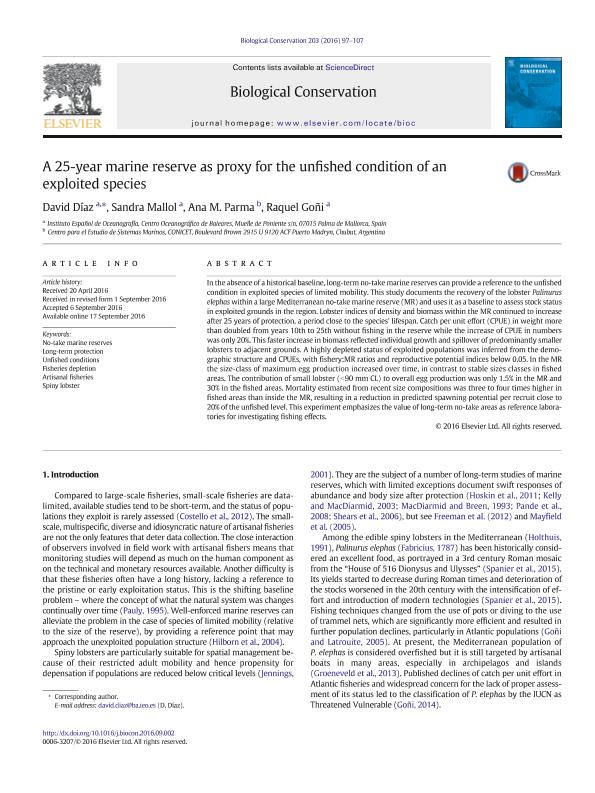Mostrar el registro sencillo del ítem
dc.contributor.author
Díaz, David
dc.contributor.author
Mallol, Sandra
dc.contributor.author
Parma, Ana María

dc.contributor.author
Goñi, Raquel
dc.date.available
2017-09-22T18:35:22Z
dc.date.issued
2016-08
dc.identifier.citation
Díaz, David; Mallol, Sandra; Parma, Ana María; Goñi, Raquel; A 25-year marine reserve as proxy for the unfished condition of an exploited species; Elsevier; Biological Conservation; 203; 8-2016; 97-107
dc.identifier.issn
0006-3207
dc.identifier.uri
http://hdl.handle.net/11336/24949
dc.description.abstract
In the absence of a historical baseline, long-term no-take marine reserves can provide a reference to the unfished condition in exploited species of limited mobility. This study documents the recovery of the lobster Palinurus elephas within a large Mediterranean no-take marine reserve (MR) and uses it as a baseline to assess stock status in exploited grounds in the region. Lobster indices of density and biomass within the MR continued to increase after 25 years of protection, a period close to the species' lifespan. Catch per unit effort (CPUE) in weight more than doubled from years 10th to 25th without fishing in the reserve while the increase of CPUE in numbers was only 20%. This faster increase in biomass reflected individual growth and spillover of predominantly smaller lobsters to adjacent grounds. A highly depleted status of exploited populations was inferred from the demographic structure and CPUEs, with fishery:MR ratios and reproductive potential indices below 0.05. In the MR the size-class of maximum egg production increased over time, in contrast to stable sizes classes in fished areas. The contribution of small lobster (b90 mm CL) to overall egg production was only 1.5% in the MR and 30% in the fished areas. Mortality estimated from recent size compositions was three to four times higher in fished areas than inside the MR, resulting in a reduction in predicted spawning potential per recruit close to 20% of the unfished level. This experiment emphasizes the value of long-term no-take areas as reference laboratories for investigating fishing effects.
dc.format
application/pdf
dc.language.iso
eng
dc.publisher
Elsevier

dc.rights
info:eu-repo/semantics/openAccess
dc.rights.uri
https://creativecommons.org/licenses/by-nc-sa/2.5/ar/
dc.subject
No-Take Marine Reserves
dc.subject
Long-Term Protection
dc.subject
Unfished-Condition
dc.subject
Fisheries Depletion
dc.subject
Artisanal Fisheries
dc.subject
Spiny Lobster
dc.subject.classification
Bioquímica y Biología Molecular

dc.subject.classification
Ciencias Biológicas

dc.subject.classification
CIENCIAS NATURALES Y EXACTAS

dc.title
A 25-year marine reserve as proxy for the unfished condition of an exploited species
dc.type
info:eu-repo/semantics/article
dc.type
info:ar-repo/semantics/artículo
dc.type
info:eu-repo/semantics/publishedVersion
dc.date.updated
2017-06-30T13:29:02Z
dc.journal.volume
203
dc.journal.pagination
97-107
dc.journal.pais
Países Bajos

dc.journal.ciudad
Amsterdam
dc.description.fil
Fil: Díaz, David. Centro Oceanográfico de Baleares. Instituto Español de Oceanografía. Palma de Mallorca; España
dc.description.fil
Fil: Mallol, Sandra. Centro Oceanográfico de Baleares. Instituto Español de Oceanografía. Palma de Mallorca; España
dc.description.fil
Fil: Parma, Ana María. Consejo Nacional de Investigaciones Científicas y Técnicas. Centro Científico Tecnológico Conicet - Centro Nacional Patagónico. Centro para el Estudio de Sistemas Marinos; Argentina
dc.description.fil
Fil: Goñi, Raquel. Centro Oceanográfico de Baleares. Instituto Español de Oceanografía. Palma de Mallorca; España
dc.journal.title
Biological Conservation

dc.relation.alternativeid
info:eu-repo/semantics/altIdentifier/doi/http://dx.doi.org/10.1016/j.biocon.2016.09.002
dc.relation.alternativeid
info:eu-repo/semantics/altIdentifier/url/http://www.sciencedirect.com/science/article/pii/S0006320716303615
Archivos asociados
